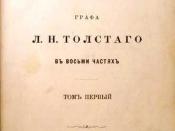By examining the character list, one immediately notices the value Tolstoy places on character. With one hundred and forty named characters and several other unnamed characters, Tolstoy places his central focus in Anna Karenina on the characters. He uses their actions and behavior to develop the plot and exemplify the major themes of the novel. In contrast to Flaubert's Madame Bovary, Tolstoy wishes to examine life as it really is. Both novels have relationships and adultery as a central theme. However, Tolstoy gives us a much more lifelike representation in Anna Karenina by creating characters, both major and minor, that contribute to the sense of realism.
The most striking feature of Tolstoy's minor characters is that although they may only appear briefly, they still possess a sense of lifelikeness. When a character is introduced, Tolstoy provides the reader with details of the characters appearance and actions that give a sense of realism.
For example, the waiter that Stiva and Levin encounter at their dinner, although a flat character is definitely presented in a manner which allows him to have a sense of lifelikeness and fullness. From the speech patterns the waiter uses to the description of the fit of his uniform, one is presented with the details that allow the waiter to contribute to the novel in means beyond simply the presence of a minor character. His description and actions provide the novel with a sense of 'real life'.
Another way in which Tolstoy gives the minor character a sense of life is by making them unpredictable. One sees this in the character of Ryabinin. When initially discussed, the reader is told that upon conclusion of business, Ryabinin will always say 'positively and finally' (p161). However upon conclusion of the sale of the land, Ryabinin does not use...


